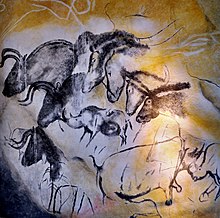Grasslands


Grassland (also primeval grassland ) is often used , especially in vegetation science, as a generic term for natural grassland , on which, depending on the climate , mainly grass and / or herbaceous plants (can) grow. The largest share of the terrestrial land surface is of such a grassy open land - biomes taken, where trees are missing or play a subordinate role.
Primeval grassland occurs predominantly in regions in which less than 400 mm of precipitation falls on an annual average and therefore there is no natural succession to bush and woodland . These include the prairies of North America, the pampas in South America, the Eurasian steppe , the grasslands of Australia and the dry savannas in the entire tropical belt , the meadow tundra in some arctic regions and the highland steppes in the American Cordillera and the Asian high mountains such as in Anatolia or Tibet .
In the transition area to forest areas and in (apparently natural) grasslands with precipitation amounts well over 400 mm per year, the formation of the grassland is often attributed to the centuries-long influence of large grazing wild animal herds ( mega-herbivore theory ) or herds of shepherds .
Due to the climatic conditions, the barren vegetation or their remoteness, grassland biotopes can generally only be used as extensive pastoral farming land ( pastoralism ). In the past this was done by non-sedentary nomads ( nomadism ), today mainly by semi-sedentary or sedentary mobile animal owners .
Examples of grassland ecosystems
- Meadow tundras , parts of the tundra in the Arctic of North America and Siberia.
-
Steppes
-
Eurasian steppe , home of the herds of Przewalski horses , the Asiatic donkey and the saiga antelope, as well as in historical times the equestrian peoples , e.g. B. the Golden Horde .
- Puszta in Hungary, the existence of which can possibly not be explained climatically, but only anthropogenic.
- Pontokaspis , named after the ancient name of the Black Sea (Pontos Euxeinos), or Wildes Feld , without geographical barriers, has always been a transit area for numerous equestrian tribes .
- Hunger steppe or Kazak steppe , a steppe-like semi-desert in the center of Kazakhstan.
- Mats in the alpine level of the Alps and other humid mountains.
- Highland steppes in the American Cordilleras ( Páramo and Puna in the Andes) and the mountains of Central Asia, especially the highlands of Tibet .
- Great Plains , the classic prairies of the North American West, which were home to several million American bison and the prairie Indians , who established a nomadic equestrian culture with the help of the horse imported from Europe.
- former mammoth steppes of the Ice Age.
-
Eurasian steppe , home of the herds of Przewalski horses , the Asiatic donkey and the saiga antelope, as well as in historical times the equestrian peoples , e.g. B. the Golden Horde .
-
Savannahs
- Serengeti , a tree-poor savannah east of Lake Victoria, and other arid savannas in Africa that are home to huge herds of wild grazing animals that undertake extensive, seasonal migrations.
- Grasslands of Australia
- Grass savannah
Wildebeest herd, Masai Mara savanna, Kenya
Cultivated grassland
Cultivated grassland or grassland is not primal grassland . It was created through nature-exploiting agriculture without site- saving or site- improving management in areas whose climatic vegetation is primarily forests. The more intensive agriculture formed the so-called cultivated grassland through the regulation of water and nutrient balance, the introduction of productive plant species and regulated usage processes in the last 200 years . > If management is too intensive, this overuse leads to a loss of biotope and structural diversity and leads to more unstable ecosystems.
Traditionally managed grassland is often a biologically very diverse ecosystem. Especially when it comes to the preservation of traditional grassland types, nature conservation goes hand in hand with the protection of cultivated landscapes . With remnants of earlier forms of culture, their value as cultural heritage is still neglected.
To date, good professional practice (GfP) in agriculture has led to a loss and endangerment of biodiversity and soil fertility .
Individual evidence
- ^ Matthias Schaefer: Dictionary of Ecology. 5th edition. Spektrum Akademischer Verlag, Heidelberg / Berlin 2003, ISBN 3-8274-0167-4 , p. 109. Note: Grasses in general includes the order Poales ; Poaceae only stands for the grasses.
- ↑ a b Hartmut Dierschke, Gottfried Briemle: Kulturgrasland: meadows, pastures and related herbaceous vegetation . Verlag Eugen Ulmer, Stuttgart 2008, ISBN 978-3-8001-5641-2 .
- ↑ Stephan Santschi: The federal government is looking for Lucerne farmers with rare meadows. In: luzernerzeitung.ch . February 17, 2019, accessed February 17, 2019 .
- ^ Gesine Hellberg-Rode: Soil erosion. hypersoil.uni-muenster.de, accessed on December 3, 2015 . Hypersoil project - University of Muenster






